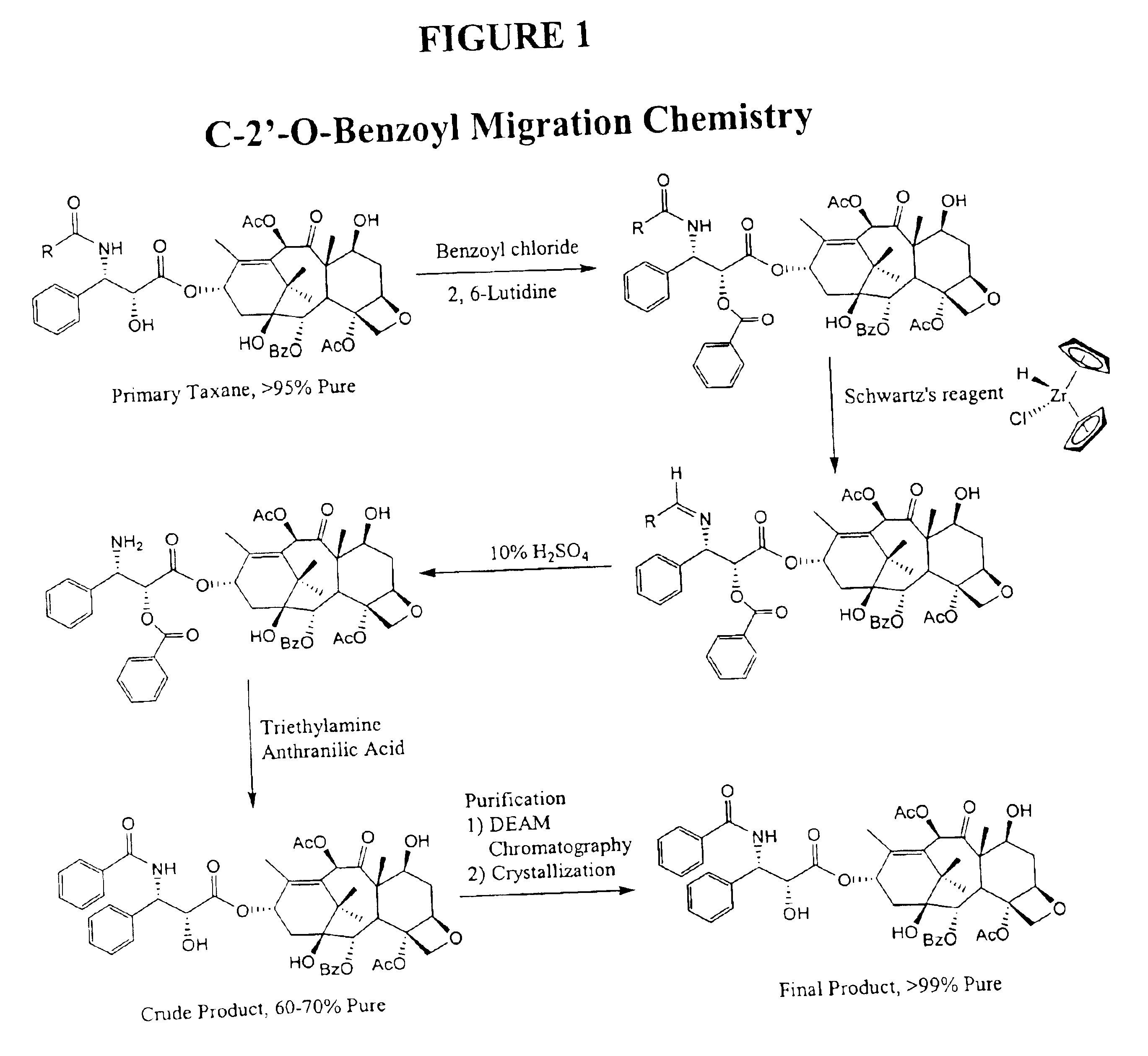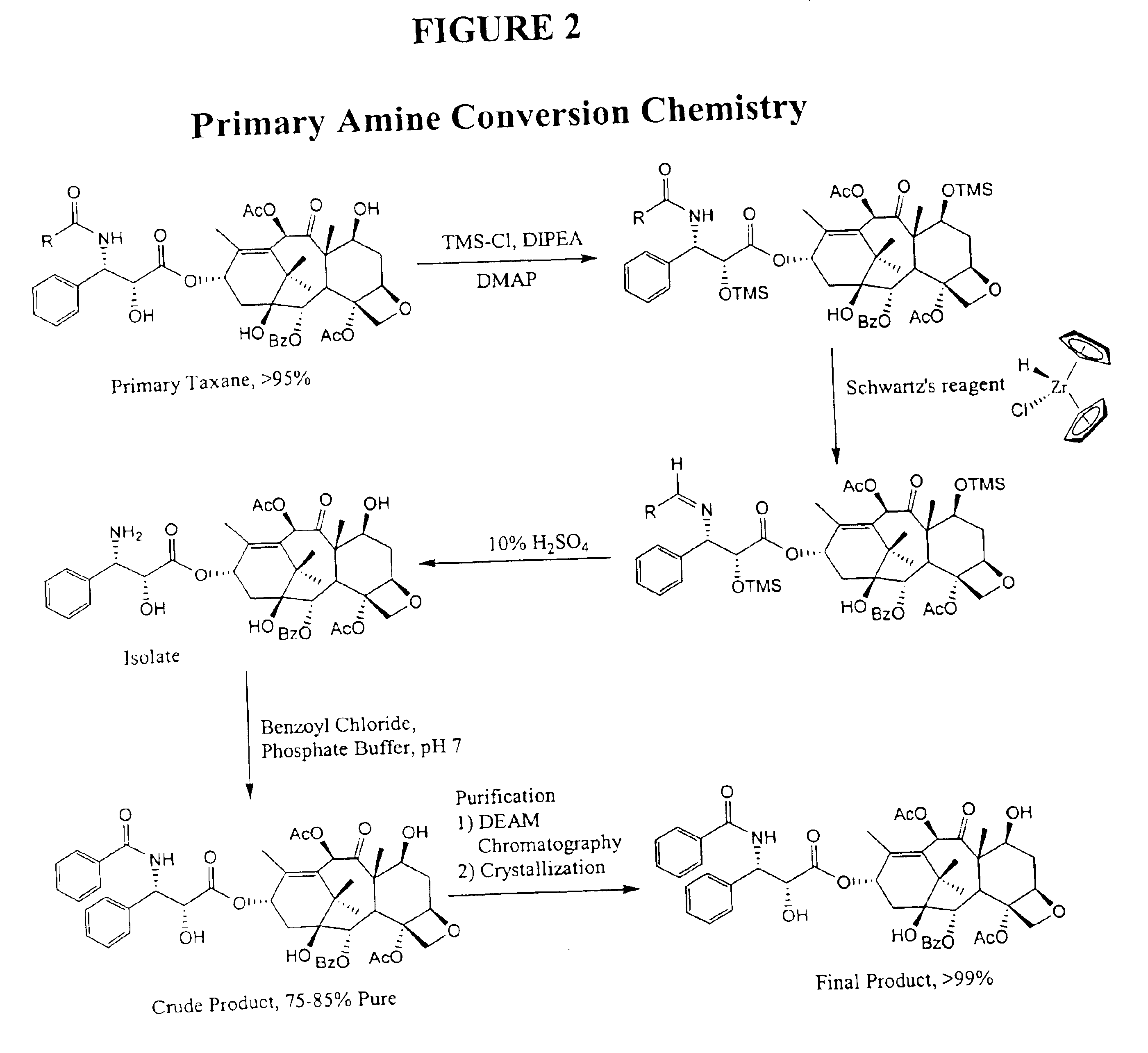Purification of taxanes and taxane mixtures using polyethyleneimine-bonded resins
a technology of polyethyleneimine and bonded resins, applied in the field of polyethyleneimine-bonded resins for purification of taxanes and taxane mixtures, can solve the problems of difficult separation of paclitaxel (taxol a) and cephalomannine (taxol b)
- Summary
- Abstract
- Description
- Claims
- Application Information
AI Technical Summary
Benefits of technology
Problems solved by technology
Method used
Image
Examples
example 1
[0097]This example shows the use of PEI Resin in the Purification of taxol A (Paclitaxel) and taxol B (Cephalomannine) from semi-purified Taxus media Densiformis extract. Here, a 75 liter column was packed with 24.5 Kg of J. T. Baker PEI resin (40 micron particle size, 275 angstrom pore size, J. T. Baker Item # 7264). The resin was equilibrated with 2 column volumes, 150 liters, of acetone containing 0.5% acetic acid at a flow rate of 3.2 liters / min. The semi-purified Taxus extract feed was then loaded onto the column at a concentration of about 250 mg / mL in acetone and at a rate of 0.5 liters / min. The concentration of taxol was 2.5 weight % or 2.5 grams of feed solid for 100 grams of PEI resin. The weight percent of taxol A and taxol B in the feed solid was 10.8 weight %. The feed was eluted with acetone containing 0.5% acetic acid at a flow rate of 3.2 liters / min. (superficial velocity=4.4 cm / min.). A total of 10 fractions were collected. Fraction 1 and fraction 10 were 75 liters ...
example 2
[0098]This example shows the use of PEI Resin in the Purification of taxol A (Paclitaxel), taxol B (Cephalomannine), and taxol C from impurities found in semi-purified Taxus brevifolia extract. Here, solid feed of semi-purified Taxus brevifolia extract was dissolved in acetone containing 0.6% acetic acid. This solution was loaded onto J. T. Baker PEI resin (40 micron particle size, 275 angstrom pore size, J. T. Baker Item # 7264). The feed load was 3% or 3 grams of feed solid for 100 grams of PEI resin. The elution solvent was acetone containing 0.6% acetic acid. As the feed components were eluted from the column, samples were collected approximately every 1 / 20th of a column volume. These fractions were analyzed by HPLC and the data was plotted as shown in FIG. 3. This run shows the separation of the impurities from taxol A, B, and C.
example 3
[0099]This example illustrates the use of DEAM resin in the purification of crude semi-synthetic taxol A (Paclitaxel). Here, the molecules used as reactants in the semi-synthetic or total synthetic process were derived from a Taxus plant, excluding Taxus brevifolia. In this example, the instrument used was a NovaPrep 200 Preparative High Performance Liquid Chromatography System combined with a Hitachi L-7400 UV detector set to a wavelength of 254 nm. Both of these units are directly connected to a PC interface which runs the LC ReSponder controller software—Version 2.11.V (R & S Technology, Inc.).
[0100]The column is a Load & Lock 2″ Preparative LC column (R & S Technologies, Inc. / Varian) which has the following dimensions: Inner Diameter=5 cm; Length=25 cm; Volume=490.87 cm3. The column is packed with Diethylaminomethyl (DEAM) Bonded Silica Gel: Spherical, 20 micron particle size, 120 angstrom average pore size. The column is packed with 270 g of resin compressed to 800 psi.
[0101]A ...
PUM
| Property | Measurement | Unit |
|---|---|---|
| pore size | aaaaa | aaaaa |
| pore size | aaaaa | aaaaa |
| pore size | aaaaa | aaaaa |
Abstract
Description
Claims
Application Information
 Login to View More
Login to View More - R&D
- Intellectual Property
- Life Sciences
- Materials
- Tech Scout
- Unparalleled Data Quality
- Higher Quality Content
- 60% Fewer Hallucinations
Browse by: Latest US Patents, China's latest patents, Technical Efficacy Thesaurus, Application Domain, Technology Topic, Popular Technical Reports.
© 2025 PatSnap. All rights reserved.Legal|Privacy policy|Modern Slavery Act Transparency Statement|Sitemap|About US| Contact US: help@patsnap.com



